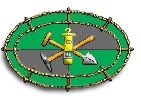The Ironbridge Gorge is a very old mining area, records date from the 13th and 14th centuries and occasional mine 'plans' survive from the 17th with some of the workings still accessible dating from the 18th Century.
![]() All underground workings in the Gorge
should be treated with respect for there are many dangers present (including
poisonous and flammable gases). It is unwise to enter any such workings, even those described in
the following pages without proper precautions, skills and equipment.
All underground workings in the Gorge
should be treated with respect for there are many dangers present (including
poisonous and flammable gases). It is unwise to enter any such workings, even those described in
the following pages without proper precautions, skills and equipment.
This area owes its past prosperity to the fast flowing streams, navigable waterways and the variety of natural resources present. These included ironstone, coal, limestone, fireclays, tileclays and brickclays, sandstone, natural bitumen or 'tar', salt, 'Walkers' earth and sand .... to name but a few!
Evidence of early working of all these resources remains and some of the important surface sites are accessible to the public today. Only one underground working is considered 'safe' however and that is the Tar Tunnel at Coalport, which is now a show-mine.
Choose a site ...
Pennystone Ironstone Adit, Ironbridge. The mine is not indicated on any known map or mine plan and is unlikely to have been active since the early 19th Century. The adit entrance is a brick-arch on St. Lukes Road, Ironbridge.
Walker's Earth Mine, Coalbrookdale. This tunnel is probably late 18th/early 19th century, although no information on its history has been located. It appears to be on the Wenlock Shale/Limestone separation and it is believed to have been worked for 'Walkers Earth'.
The Jockey Bank area (Madeley Green) - Wesley Road Tunnel, Tramway Tunnel, Bedlam Adit(s), Stone Pit Tunnel, Lower Stone Pit Tunnel, possible Pennystone Adit, Clay Adits.
Brookes/Cluddes Insetts, Madeley Bank. Early mine sites dating from the 1600's, originally controlled by Sir Basil Brooke (1576-1646), Lord of the Manor of Madeley.
The Lloyds Area (western part) - Baughs Pit, Middle Pit, Dales Pit, Lloyds Clay Pit, Lloyds Crawstone Pit, New Coppice Pit, Union & Wharf Pits.
The Lloyds Pumping Pit - an early steam engine site, which later became a central pumping station for mines in the Lloyds area.
The Lloyds Area (eastern part) - Old Coppice Pit, Water Engine Air Pit, Walletts Pit, New Hill (Dingle) Pit, Cape Pit.
Note
The articles on the Ironbridge Gorge Tunnels above are written by Dr.I.J.Brown, who for over 50 years has been scouring the hillsides
of the Gorge for indications of mining, and following up reports of 'holes' and 'shafts' and likely references to these on maps, plans and other documents.
This series of pages is intended to indicate the wealth of material that has been obtained, but it should be remembered that much of it has been collected in a professional capacity using accepted procedures. The ad-hoc approach to mine exploration particularly in the Coal Measures of the Gorge is NOT to be recommended.
For more details on the location, geology and usage of the various minerals the writer's paper "Underground in the Ironbridge Gorge" in Industrial Archaeological Review Vol. III No. 2 Spring 1979 is to be recommended.
Further Reading
- "Mining in Shropshire", produced by the Club (Ed. Adrian Pearce), published by Shropshire Books, 1995 (ISBN 0 903802 63 5)
- "The East Shropshire Coalfields", complied by Ivor J.Brown, published by Tempus, 1999 (ISBN 0 7524 1705 3)
- "The Mines of Shropshire", by I.J.Brown, published by Moorland Publishing Company, 1976 (ISBN 0 903485 32 X) - out of print, so ONLY available second-hand.
Present Day Access
Access to many of these sites is now much more limited than in the past.
Surface access has been affected by disputes over footpath rights, much
more fencing has occurred and vegetation has taken off with a vengeance.
In addition recent housing developments have on occasion covered up previously
visible remains and entrances have been filled-in or gated.




